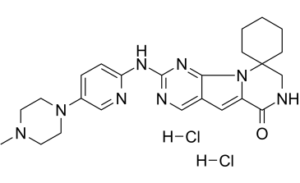Trilaciclib hydrochloride (G1T28)
This product is for research use only, not for human use. We do not sell to patients.

For small sizes, please check our retail website as below: www.invivochem.com
| Size | Price | Stock |
|---|---|---|
| 50mg | $500 | Check With Us |
| 100mg | $900 | Check With Us |
| 200mg | $1350 | Check With Us |
Cat #: V31977 CAS #: 1977495-97-8 Purity ≥ 98%
Description: Trilaciclib hydrochloride (G-1T28; Cosela), the hydrochloride salt of Trilaciclib, is a short-acting CDK4/6 inhibitor with anticancer activity.
Top Publications Citing Invivochem Products
Publications Citing InvivoChem Products
Product Promise

- Physicochemical and Storage Information
- Protocol
- Related Biological Data
- Stock Solution Preparation
- Quality Control Documentation
| Molecular Weight (MW) | 519.47 |
|---|---|
| Molecular Formula | C24H32Cl2N8O |
| CAS No. | 1977495-97-8 |
| Protocol | In Vitro | Incubation with Trilaciclib hydrochloride (G1T28) for 24 hours induces a robust G1 cell-cycle arrest (time=0). By 16 hours after Trilaciclib hydrochloride washout, cells have reentered the cell cycle and demonstrate cell-cycle kinetics similar to untreated control cells. These results demonstrate that Trilaciclib hydrochloride causes a transient, and reversible G1 arrest. A transient Trilaciclib hydrochloride-mediated G1 cell-cycle arrest in CDK4/6-sensitive cells decreases the in vitro toxicity of a variety of commonly used cytotoxic chemotherapy agents associated with myelosuppression |
|---|---|---|
| In Vivo | Trilaciclib hydrochloride (G1T28) treatment results in a robust and dose-dependent suppression of proliferation in HSPCs at 12 hours, with 5-ethynyl-2′-deoxyuridine (EdU) incorporation returning near baseline levels in a dose-dependent manner by 24 hours after administration. These data demonstrate that a single oral dose of Trilaciclib hydrochloride can produce reversible cell-cycle arrest in HSPCs in a dose-dependent manner in vivo. Mice given 100 mg/kg Trilaciclib hydrochloride 30 minutes prior to etoposide treatment, exhibits only background levels of caspase-3/7 activity. These data demonstrate that Trilaciclib hydrochloride can protect the bone marrow from chemotherapy-induced apoptosis in vivo. The data demonstrate that treatment with Trilaciclib hydrochloride prior to 5-fluorouracil (5-FU) likely decreases 5-FU-induced damage by chemotherapy in HSPCs, thus accelerating blood count recovery after chemotherapy |
These protocols are for reference only. InvivoChem does not
independently validate these methods.
| Solvent volume to be added | Mass (the weight of a compound) | |||
|---|---|---|---|---|
| Mother liquor concentration | 1mg | 5mg | 10mg | 20mg |
| 1mM | 1.9250 mL | 9.6252 mL | 19.2504 mL | 38.5008 mL |
| 5mM | 0.3850 mL | 1.9250 mL | 3.8501 mL | 7.7002 mL |
| 10mM | 0.1925 mL | 0.9625 mL | 1.9250 mL | 3.8501 mL |
| 20mM | 0.0963 mL | 0.4813 mL | 0.9625 mL | 1.9250 mL |
The molarity calculator equation
Mass(g) = Concentration(mol/L) × Volume(L) × Molecular Weight(g/mol)
Mass
=
Concentration
×
Volume
×
Molecular Weight*
The dilution calculator equation
Concentration(start)
×
Volume(start)
=
Concentration(final)
×
Volume(final)
This equation is commonly abbreviated as: C1 V1 = C2 V2
Concentration(start)
C1
×
Volume(start)
V1
=
Concentration(final)
C2
×
Volume(final)
V2
Step One: Enter information below
Dosage mg/kg
Average weight of animals g
Dosing volume per animal µL
Number of animals
Step Two: Enter the in vivo formulation
%DMSO
+
%
+
%Tween 80
+
%ddH2O
Calculation Results:
Working concentration:
mg/ml;
Method for preparing DMSO master liquid:
mg
drug pre-dissolved in
µL
DMSO(Master liquid concentration
mg/mL)
,Please contact us first if the concentration exceeds the DMSO solubility of the batch of drug.
Method for preparing in vivo formulation:
Take
µL
DMSO master liquid, next add
µL
PEG300, mix and clarify, next add
µL
Tween 80,mix and clarify, next add
µL
ddH2O,mix and clarify.
Note:
- (1) Please be sure that the solution is clear before the addition of next solvent. Dissolution methods like vortex, ultrasound or warming and heat may be used to aid dissolving.
- (2) Be sure to add the solvent(s) in order.




































